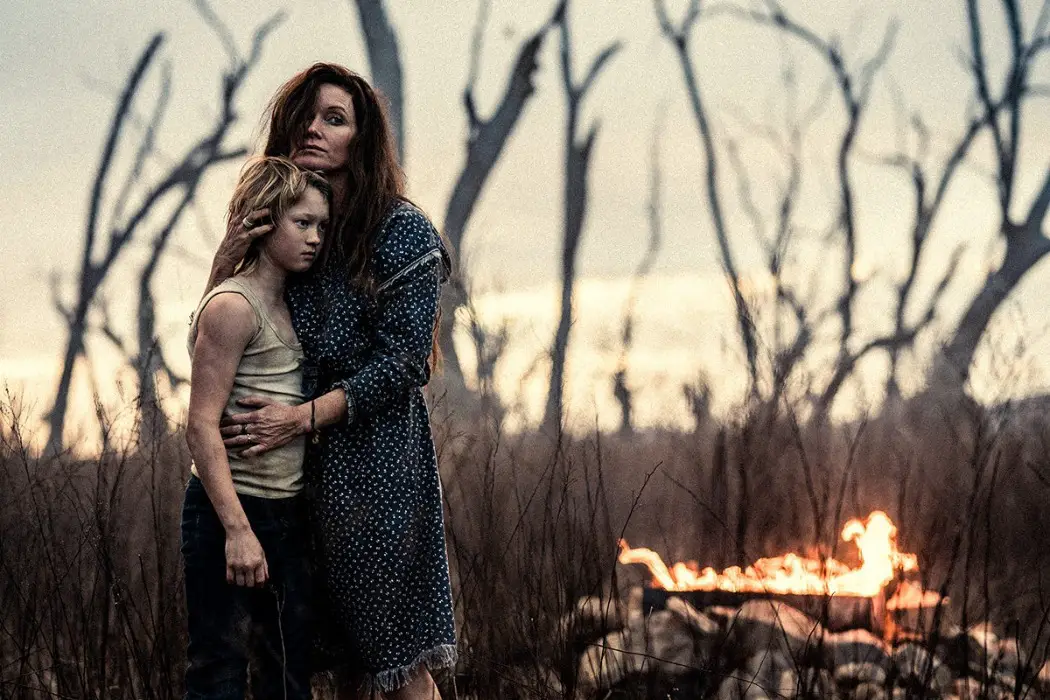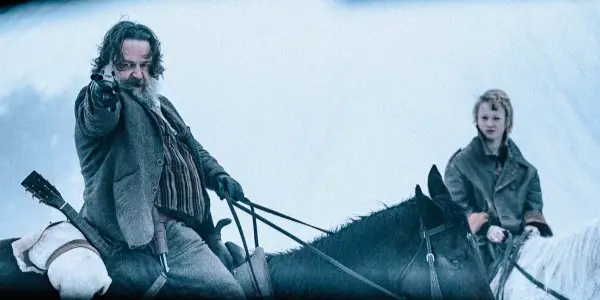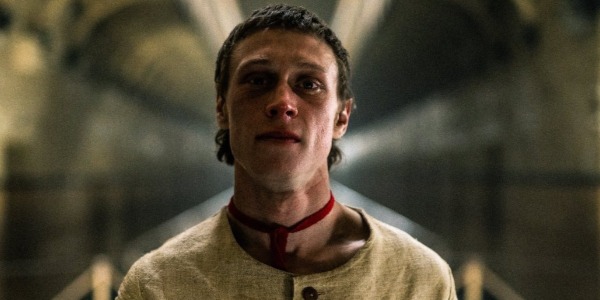THE TRUE HISTORY OF THE KELLY GANG: The Fate Of Father Figures

Alex is a 28 year-old West Australian who has a…
Early in The True History of the Kelly Gang, the fourth feature film by Australian director Justin Kurzel, we are introduced to the first father figure that’ll help mould a young Ned Kelly into the horse thief and murderer that he’s practically doomed to become. The role of the male sculptor has surfaced in each of Kurzel’s highly polarising works; while his trippy Macbeth adaptation isn’t as explicit with its importance in the narrative, both Snowtown and Assassin’s Creed traced the blood on the hands of reluctant murderers from the lineage of beguiling fatherly surrogates.
This time, in adapting Peter Carey’s 2000 novel of the same name, not only has the director returned to the territory (both geographically and thematically) that originally made him one to watch (before the Michael Fassbender-starring Assassin’s Creed suggested otherwise), but his time in Hollywood has expanded his horizons, giving him the canvas to lavishly sketch this repulsively scenic character drama that takes a rusted blade to the “based on a true story” brand of historical sagas with intoxicating results.
Based on a True Story
To say that The True History of the Kelly Gang is an inconsequential affair due to its fictitious reimagining of real-world affairs, would mean that Martin Scorsese’s wonderful revisionist epic, The Irishman, could be painted with the same trivial brush. We know that this judgement on both films is objectively wrong, but it’s this sense of mythical misconception that Shaun Grant’s screenplay is squarely aimed at; it stirs the question of when the myth becomes greater than the man, does the man no longer matter?

In a country where Ned Kelly’s helmet is as ubiquitous as the kangaroo or even the Mickey Mouse logo, does recasting Kelly’s story through new lenses – especially with a character whose dense cinematic history has been repeated more than amiable idols like Peter Pan or Robin Hood – even matter at this stage? Hell, Abe Forsythe took a swing in 2003 with the aptly-named Ned and we still got the straight-laced Heath Ledger adaptation several years later.
The journey may be different, but the catastrophic destination remains the same, with the choking sense of inevitability haunting the film’s very first frame: In the embers of a once-rich bushland, the redcoat-wearing Ned Kelly (George Mackay) races across the dead sands, the single pulse rate in this torched hell-scape. Gone are the clinically immaculate aesthetics of Assassin’s Creed, as Ari Wegner captures this apocalyptic landscape with a harsh and unwavering gaze – mirroring young Ned Kelly’s own hesitant assimilation into this unforgiving terrain – but his attitude to representing 1850’s Australia is not one designed alone.
Wegner’s grip on the camera comes with John Hillcoat’s dirt underneath his fingernails; remnants of his grimly macabre, mud-soaked westerns (The Proposition in particular) that helped define the contemporary Australian image in cinema – securing a phantasm that was recently deconstructed again in Warwick Thornton’s Sweet Country, which poetically enough, was an infuriated response to projects like this.
Nature Versus Nurture
When we first meet the tattered Kelly family, their despondent existence is being desperately managed by downbeat ex-con father Red (Gentle Ben Corbett) and mother Ellen (Essie Davis), with the latter’s prostitution profession, whilst demeaning, being the only thing keeping them and the kids from total collapse. One regular customer to their crumbling abode is British Sergeant O’Neill (Charlie Hunnam), who is the first father figure to really make an impression on Ned Kelly – initially warning him of how the world will eventually chew him up and spit him out (and Kurzel’s film spends the rest of the run-time making good on that morbid promise).
Their brief interactions reflect a microcosm of the savage war warring in the background, the unwinnable contest between man-made law and order, represented by the British officers who sagely patrol the Victorian desert, and the anarchy of the Australian outback, as they wrestle for total control, infecting and eventually rupturing Kelly’s own splintered state of mind. This territory was explored with equal fury in Jennifer Kent’s grim revenge fable The Nightingale, which also posited the invading British force as an unwelcome vermin on society with a similar sense of texture and temperature, but The True History of the Kelly Gang is more consciously disruptive; an anarchistic punk-rock soundtrack recalls the anarchic attitude of Alex Cox’s corresponding historical deviations.
Another modern alteration is the frequent use of strobe lights to accentuate mania, which is effectively physically and visually displacing; the final, absolutely manic firefight, where Kelly dons his Helmet – with the same dignified energy of Iron Man slipping on his suit – amongst a sea of blinking bullets that feels more like a rave party than a bloody last stand. It’s in the film’s closing third, when hope is lost and Kelly has unwittingly accepted the lifelong credit of “career criminal”, that a fast, feverish side of Justin Kurzel suddenly erupts, unleashing a surrealist, no-holds-barred energy from the oft-sombre director. It’s an exciting turn not only for the transformation of the character, but the director too, with comparisons to Alejandro Landes’s festival hit Monos not being unwelcome.
Manic Moonlight
Chaptered into three distinctive segments – Boy, Man and Monitor – Kelly Gang consorts nicely with Moonlight’s similar structure of male development, with the second step introducing us to the adult Kelly, played with an exhausting physicality by George Mackay – not dissimilar to his work in 1917, albeit with less melodrama – whose troubled childhood made him swap out his dysfunctional family for a bruised and bruising camaraderie with a band of male misfits. Mackay’s wounded portrayal of the Australian icon furiously fights against the overwhelming odds thrown his way – whether it be in the backyard boxing matches he competes in or his stunted life in general.

With his wicked matriarchal mother pushing him to protect his family at any cost – including his young partner (Thomasin McKenzie) and their bastard child – Kelly struggles to balance time with his family and his close mates who concern themselves with wearing women’s dresses (the explicit homoeroticism that illustrate’s Kurzel’s interpretation of events is bound to offend upon release) and indulging in petty crime. The straw that breaks the camel’s back comes in the form of Nicholas Hoult, a corrupt British offical whose slippery persona beckons Kelly to become the pistol-wielding madman who’ll go onto define our iconography forever.
It’s important that Kelly’s mother is as much of a father figure in his life as the other adults who enter the picture (not only because of the film’s complications of gender); Kurzel’s refusal to blame a singular role parlays itself into blaming Kelly’s unwieldy transformation not on one influencer, but on a company of oppressors, beginning with the cut-throat morality lessons imbued by Charlie Hunnam, a youth twisted by the poetic words of Russell Crowe’s magnificently-bearded Harry Power and a sense of stability shattered by the Bible serpent serenades of Nicholas Hoult, who is another personality in Kelly’s life to indulge in the act of cross-dressing, with each new addition to the titular “Kelly gang” – whether by blood or bond – each forming a new piece within the jagged jigsaw that is his tortured upbringing.
The True History of The Kelly Gang: Conclusion
If there’s one thing to take away from the abrasive experience of The True History of the Kelly Gang, is that it teaches us to not judge a book by its cover, with Peter Carey’s cleverly-misguiding title proving as such; while we’re presented with the aggressively male, sweaty brute known as Ned Kelly – whose reputation is solely based around his abhorrent crimes – his interior lyrical thoughts, jotted down in a passionate fury at all times, demonstrate a more formidable felon underneath the blemished charade.
Upon release, this will be unsurprisingly divisive. Its limited theatrical release in Australia is understandable given how caustic and unconventional it is, despite the star power involved. It’s often punishing and resistant to facile translation, but there’s no denying the merciless power that Justin Kurzel brings, equating to what I would consider his best film yet; the jarring contempt is balanced by its formal pleasures.
For countless decades, every history book reported that Ned Kelly’s final words, as the noose was being draped around his neck, were “Such is Life”. While often disputed and forever incontestable, what Justin Kurzel’s bold retelling of events proposes is: why can’t both versions of the story be true?
The True History of the Kelly Gang will be released on the Australian streaming service Stan on January 26th.
Does content like this matter to you?
Become a Member and support film journalism. Unlock access to all of Film Inquiry`s great articles. Join a community of like-minded readers who are passionate about cinema - get access to our private members Network, give back to independent filmmakers, and more.













